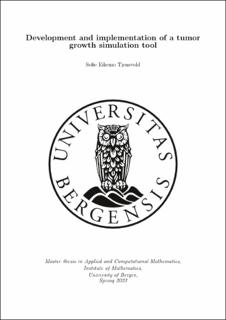| dc.description.abstract | This thesis presents the development and analysis of a mathematical model for avascular tumor growth. The model considers the influence of externally supplied nutrients as growth-promoting factors, growth-inhibiting factors produced by tumor cells during the cell cycle or excreted by necrotic cells, and growth-inhibiting factors produced by the surrounding tissue as a result of the immune system's response to the tumor. The concentrations of these factors are modeled using advection-diffusion partial differential equations. The mathematical model is implemented using forward Euler, backward Euler, and Finite Element methods for discretization. The FEniCS library has been used with respect to the Finite Element method during the implementation. Furthermore, the implementation shows that the mathematical model is in alignment with known tumor evolution. Examinations of various model parameters are conducted, revealing their impact on avascular tumor growth. The examinations showed that alterations in parameters related to nutrients and the internally produced/excreted growth-inhibiting factors had the most significant impact on tumor development. Therefore, it is crucial that these parameters are set to biologically accurate magnitudes to ensure that the simulated tumor development and patterns are qualitatively correct. Additionally, the strong dependency on these parameters suggests that drugs targeting and influencing these parameters have the potential to inhibit tumor growth. Additionally, it was observed that modifications of parameters related to the internally generated or the externally supplied growth-inhibiting factors could significantly alter where quiescent regions formed, and thus result in completely different growth patterns. Furthermore, altering the proportion constituted by the extracellular matrix within the tumor was also observed to significantly influence tumor evolution. Moreover, these findings highlight the potential benefits of developing more detailed models that comprehensively analyze the influence of these parameters. Such models could contribute to the development of experimental approaches and enhance our understanding of tumor evolution. | |
